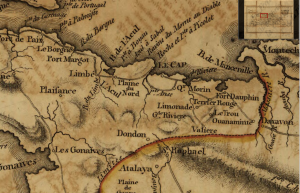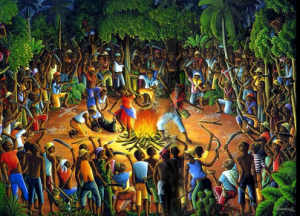Deeps > Representing Bois Caïman > Genealogy of Bois Caïman Textual Sources > Debates about Bois Caïman
Carte de l’Isle St. Domingue 1796 (Library of Congress)
Debates about the location of Bois Caïman:
Antoine Dalmas in his 1814 account indicates the location of Bois Caïman. He writes that before starting the insurrection “they had a kind of celebration of sacrifice in the middle of an uncultivated woods on the Choiseul plantation, known as Caiman, where the negres gathered in great numbers.”[1]
Christian Girault in his 1985 Atlas places the event in the center of the Acul parish.[2]
Emmanuel Francius Julien, a Haitian professor, in his book “Le Cérémonie du Bois Caïman,” places the event on Nan Campeche in the Acul parish.[3]
Gerard Barthelemy claims that the Bois Caïman ceremony took place in the hills above Le Normand de Mezy.[4]
David Geggus follows Dalmas in placing the ceremony on the Choiseul plantation. He notes that while that areas has now been deforested, “on the most detailed late-eighteenth century map of the northern plain, however, the Lagon a Cayman appears as a swamp surrounded by woods spanning the Choiseul and Dustou plantations.”[5]
Debates about the Date of Bois Caïman:
Carolyn Fick places the date of Bois Caïman on Aug. 14th 1791, following the Morne-Rouge Assembly of slaves,[6] as does most of Haitian tradition with commutative ceremonies often taking place on August 14th.
David Geggus contends that there was an assembly of elite slaves on Aug 14th at the Lenormand de Mezy but that the Bois Caïman ceremony took place on the 21st at the Choiseul plantation.[7]
Leon-Francois Hoffman, a French historian, claimed in the 1990’s that Bois Caïman never actually happened but was fabricated by Antoine Dalmas in an attempt to discredit Haiti.[8]
Thomas Madiou is a significant early source for those who question the historicity of Bois Caïman because of his surprising lack of any mention of the ceremony.[9]
David Geggus argues for the historicity of Bois Caïman, however he questions the validity of the details of many od the sources including the idea that Boukman as present for the ceremony.[10]
For an interesting debate about the historicity of Bois Caïman, see: THE BOIS CAÏMAN CEREMONY: FACT OR MYTH
Return to Bois Caïman Textual Genealogy Page
[1] Antoine Dalmas, “History of the Revolution of Saint-Domingue: 1814,” in Laurent Dubois and John D. Garrigus’, Slave Revolution in the Caribbean, 1789-1804: A Brief History with Documents (Basingstoke: Palgrave Macmillan, 2006), 90. [2] C. Girault et al., Atlas d’Haiti (Talence: Universite de Bordeaux, 1985). [3] J. B. Emmanuel Francius Julien. La cérémonie du bois-caïman. [Haiti]: L’Ordre Nouveau, 1980, 45. [4] Gerard Barthelemy, “Propos sur le Caïman: incertitudes et hypotheses nouvelles,” Chemins Critiques 2 (1992): 36, 54-56. [5] David Geggus, Haitian Revolutionary Studies, (Bloomington, IN: Indiana University Press, 2002), 86. [6] Carolyn E. Fick, The Making of Haiti: The Saint Domingue Revolution from Below, (Knoxville: University of Tennessee Press, 1990), 260-263. [7] Geggus, Haitian Revolutionary Studies, 83-87. [8] Leon-Francois Hoffman, “Un mythe national: la ceremonie du Bois Caïman,” in La République haïtienne: état des lieux et perspectives, ed. Gérard Barthélemy and Christian A. Girault (Paris: Karthala, 1993), 434-448. [9] Thomas Madiou, Histoire d’Haiti (1847-1848; reprint, Port-au-Prince: H. Deschamps, 1989-1991). [10] Geggus, Haitian Revolutionary Studies, 81-92.



love this